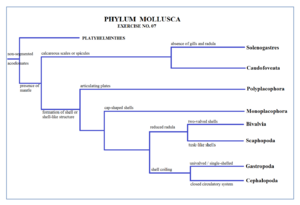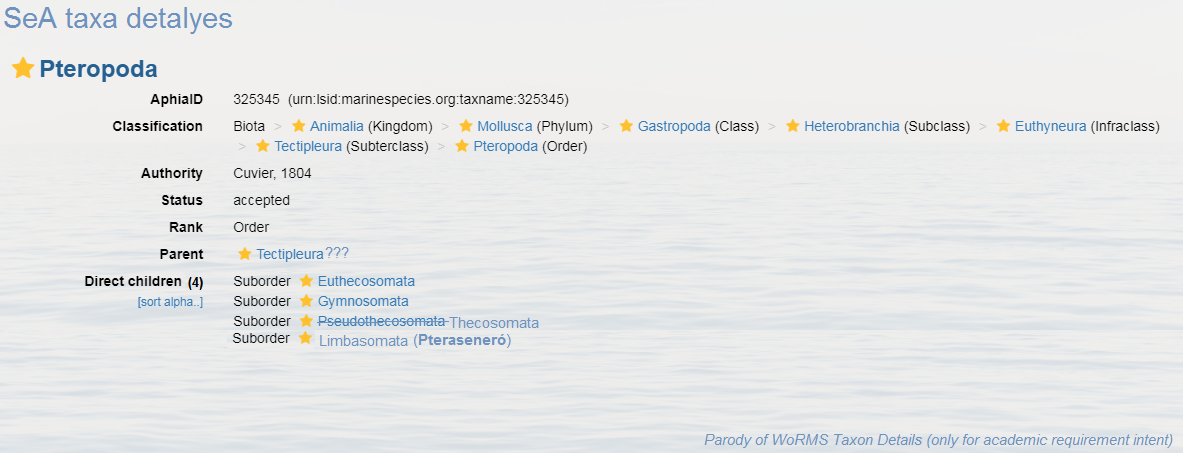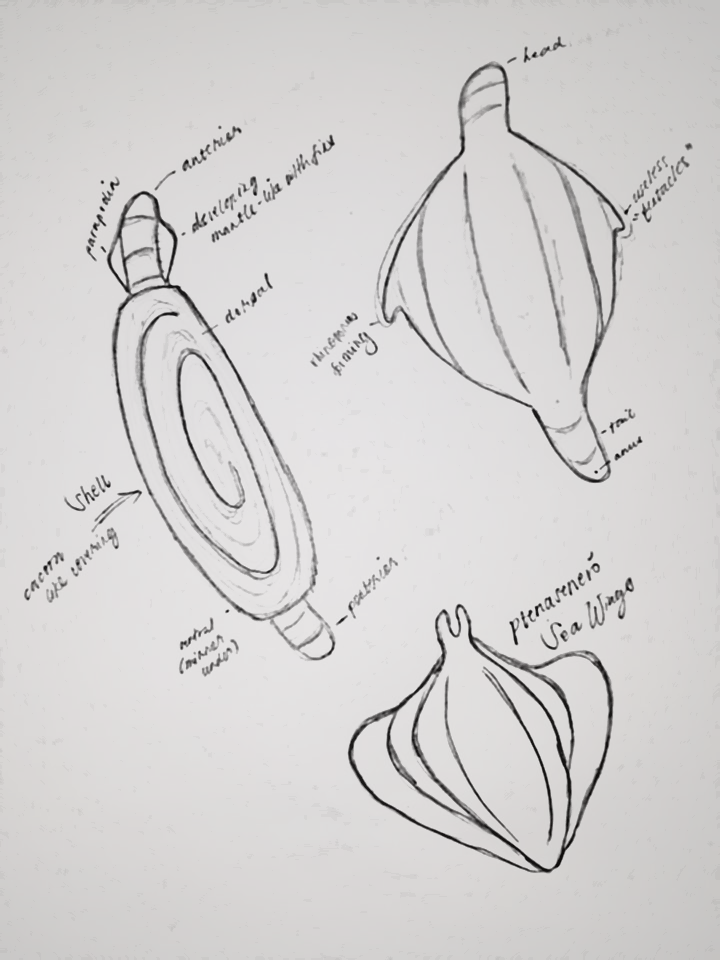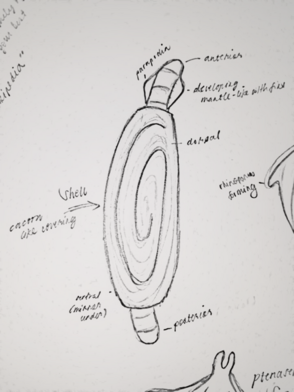User:Patriciap
Patrionus limbagajo[edit | edit source]
From Uncyclopedia, the content-free encyclopedia that anyone can edit. *Disclaimer: for creative MB13 Laboratory project purpose only, not to be used as an actual or realistic reference, content is based on imagination and academic requirement only intent*
- Not to be confused with Gymnosomata
- Not to be confused with Theropoda, dinosaurs and Pteropodidae, megabats and Pteranodon, flying reptile
Patrionus limbagajo (common name: pteraseneró, from the Greek word meaning "flying-in-water") are included in the marine class Gastropoda(old) or Subclass Heterobranchia, under the informal group or Order Opisthobranchia as Suborder Limbasomata, they are planktonic and can reach up to twice the size of a Rice Krispies (1cm). This species is not to be confused with sea butterflies (from Suborder Thecosomata) or sea angels (from Suborder Gymnosomata). The Patrionus limbagajo species belong to an unofficial monophyletic group connected to the Thecosomata and Gymnosomata and can be referred to as Limbasomata, under Suborder Pteraseneró. The phylogenetic tree of the Pteraseneró is a significant subject for a lengthy debate, thus, it is, for now, an unofficial subgroup connected to the sea butterflies and sea angels, and may also be referred to as paraphyletic to an extent; they are to be considered as paraphyletic concerning cephalopods in terms of the presence of a mantle (vestigial), with fins incorporating its low Reynolds number (Re) instead of its full parapodia found in Pteropoda. The current consensus that is guided by reflective studies, allows interpretation of the species to lean towards the group as more monophyletic than paraphyletic and falls under Phylum Mollusca, Class Gastropoda, Subclass Opisthobranch,.
While the Pteropoda encompasses the two clades Thecosomata which are the sea butterflies and the Gymnosomata as the sea angels. The Limbasomata can be regarded as its sister taxa under Pteraseneró. The Thecosomata ("shelled-body"), literally with the presence of a shell, while the Gymnosomata meaning "naked body," do not have shells...duh. The two clades may or may not be sister taxa; if not, their similarities in terms of habitat (pelagic), size (small/microscopic) and, transparent bodies with wing-like flaps (parapodia) protruding from their bodies may be mirrored due to adaptations. Their connection to the third and unofficial suborder refers to their taxon as polytomy
| “ | It is this magical transformation that is inspiring in so many ways. | ” |
Phylogeny[edit | edit source]
SeA Taxon Detail[edit | edit source]

Brief History[edit | edit source]
Pteropods are common planktonic mollusks living in all marine environments, from the poles to the equator, from the surface to the bathypelagic depths; most species are oceanic but many penetrate coastal waters; though real neritic representatives are not recognized.[3] Pteropods are not the only pelagic molluscs. Besides the Cephalopoda, there are the pelagic prosobranchs, Heteropoda and several opisthobranch Nudibranchia, while in the Lamellibranchia one species, Planktomya henseni, is considered planktonic.[3]
The only found species under Limbasomata, Patrionus limbagajo, is unofficially accepted as part of the Pterapoda as Pteraseneró because of its vestigial mantle with dumbo-like sized fins (or dumbo's ears) as an evolving imperfect organ degenerating to wing-like structures or a parapodia. Look at definition: a degenerate or imperfectly developed organ or structure that has little or no utility, but that in an earlier stage of the individual or in preceding evolutionary forms of the organism performed a useful function.
The Limbagajo sp. is newly discovered thus, no additional evolutionary history information can be stated. Please check (Patriciap (talk)) for further updates.
Further General Information About Species[edit | edit source]
The weirdest thing about this species would be its life cycle similarities to that of the terrestrial muse and its marine muse. Think of the case-bearing clothes moth, such as the picture on the right. [7] It was only recently when I learned about the actual name of this species, thus, it had been the terrestrial muse for this imaginative project for MB 13 - Marine Invertebrates. On the other hand, its marine muse refers to the diverse Class Gastropoda, specifically the Opisthobranchia (Pteropoda - Pteraseneró)
The Patrionus limbagajo is similar in terms of the life cycle to its terrestrial and marine muses. It goes through four known stages:
- Egg Stage - similar to the Pteropods, it is delivered to the gelatinous ribbons or balls. Internal fertilization.
- Larvae Stage - similar to that of the case-bearing moth, it creates some kind of soft cocoon made of its mucus that can be regarded as closely linked with the velum presence in the pteropoda, the process just before the development of the "wings", leading to the next stage there is shell reduction
- Metamorphosis - one difference between the pteropoda and pteraseneró is this stage. The pteropods will develop the parapodia while the pteraseneró has more of a mantle-fin type of wings rather than the lateral expansion of the organism's foot. It is a ciliated mantle-fin (rare presence of degenerated or not yet evolving tentacles to possible arms), Larvae veligers carry a thimble-shaped shell that is lost in the transition to the 3rd stage, for the Sea Wings, their shells are reduced or lost in the earlier changes compared to the other two.
- Juvenile Stage - young adult, the Sea Wings already have the body of the adult, they only grow to about twice the size of Rice Krispies piece, thus, its other nickname, Krispies.
- Adult - protandric hermaphrodites, similar to that of the normal pteropods.
Further Readings can be done here.
Morphological Characteristics[edit | edit source]
The Patrionus limbagajo" falls under Order Pteraseneró. This species is the only recognized free-swimming marine species under this suborder. Understand that this is a new *imaginative* species.
| Characteristics | Gymnosomata | Thecosomata | Limbasomata |
|---|---|---|---|
| Common Name: | Sea Angels | Sea Butterflies | Sea Wings |
| Diet: | Carnivores | Herbivores | Omnivores |
| Life Cycle: | protandrous hermaphrodites | protandrous hermaphrodites | protandrous hermaphrodites |
| Shell Description: | "naked body" | "shelled body" | shedding in metamorphosis |
| Other Info: | Smaller wings, sucker-bearing tentacles for feeding (fast-strike response, hunting), lack mantle cavity | large parapodia, wings for swimming and suspension-feeding using cilia (secretes mucus to catch food), shells are delicate and can be damaged easily, retain mantle cavity | body is wings, gills on the tips or roof of the mantle, secretes mucus to catch preys |
Illustration[edit | edit source]
References[edit | edit source]
- 1. Britannica, T. Editors of Encyclopaedia (2014, October 20). pteropod. Encyclopedia
- 2. Britannica. https://www.britannica.com/animal/pteropodBritannica, T. Editors of Encyclopaedia (2018, May 4). opisthobranch. Encyclopedia Britannica. https://www.britannica.com/animal/opisthobranch
- 3. Marine Species Identification Portal : Group Pteropoda. (n.d.). Species-Identification.org. Retrieved December 13, 2021, from http://species-identification.org/species.php?species_group=pelagic_molluscs&id=5&menuentry=groepen
- 4. Phylogenetic Trees. (2021, March 6). https://bio.libretexts.org/@go/page/13526
- 5. WoRMS - World Register of Marine Species - Pteropoda. (n.d.). Www.marinespecies.org. http://www.marinespecies.org/aphia.php?p=taxdetails&id=325345
- 6. Definition of opisthobranch | Dictionary.com. (n.d.). Www.dictionary.com. Retrieved December 13, 2021, from https://www.dictionary.com/browse/opisthobranch
- 7. Paula Ramos-Silva, Deborah Wall-Palmer, Ferdinand Marlétaz, Frédéric Marin, Katja T.C.A. Peijnenburg, Evolution and biomineralization of pteropod shells, Journal of Structural Biology, Volume 213, Issue 4, 2021, 107779, ISSN 1047-8477, https://doi.org/10.1016/j.jsb.2021.107779.(https://www.sciencedirect.com/science/article/pii/S1047847721000848)
- 8. Marine Species Identification Portal : Pelagic Molluscs : Glossary : velum. (n.d.). Species-Identification.org. Retrieved December 13, 2021, from http://species-identification.org/species.php?species_group=pelagic_molluscs&selected=definitie&menuentry=woordenlijst&record=velum
This page is a work in progress |






